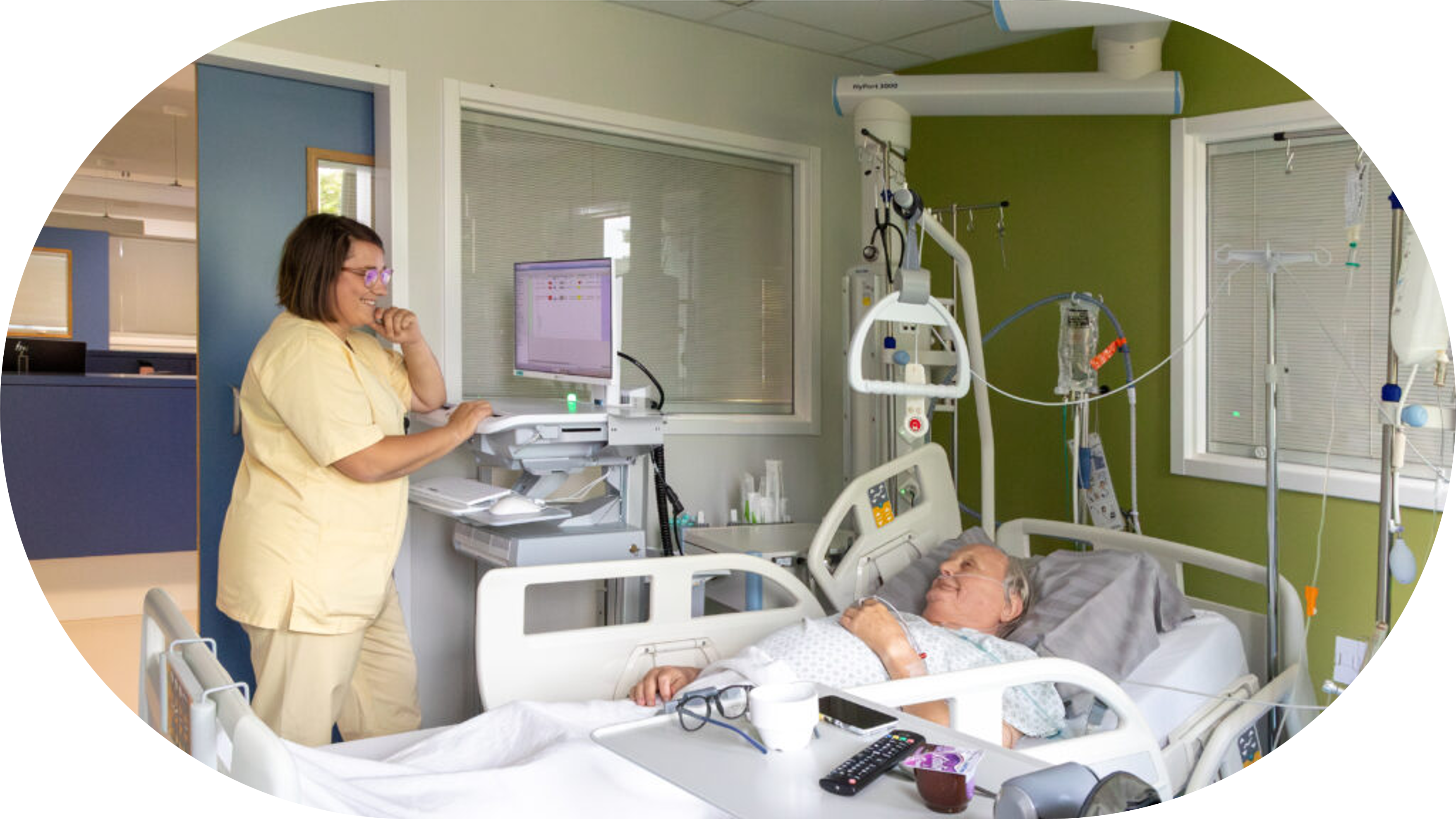Contact the following healthcare facilities directly:
MS Center Melsbroek
AZ Turnhout
Sint-Trudo Sint-Truiden
AZ Glorieux Ronse
AZ Jan Portaels Vilvoorde
Rehabilitation Hospital Inkendaal
4th of September 2023

Barely a few weeks after the start-up, nurses and doctors at the intensive care unit at RZ Heilig Hart Tienen are in full agreement: KWS (Clinical Workstation), the electronic patient record, makes a world of difference. Both for care providers and patients. So what are the main advantages and surprising side effects? How was the integration of the system, and what does the future hold? Several IZ and ICT staff at the regional hospital talk about their experiences.
Back in 2019, RZ Heilig Hart Tienen began rolling out the Clinical Workstation (KWS). Thus, for example, ICT manager Wim Lambrechts has been familiar with nexuzhealth's software suite for healthcare institutions for some time. "Intensive Care was the last hospitalisation department in the queue. Not a coincidence, because it is the service with the most complex care parameters and plans. With our self-written EPR (electronic patient record), we never managed to fully digitise everything at the time. Now we are succeeding. Is KWS the best system on the market? No doubt there are lots of great applications, but none offer the same kind of transparency and flow of information between departments."
And that is certainly crucial for Intensive Care. "Not only due to the collaboration between our twenty nurses and five intensivists", says Marc D'Hondt, head nurse ad interim during the start-up of KWS. "Our lines of communication with the various paramedics, the maintenance team, and the warehouse staff, are also important for surrounding the patient with the highest quality care. Moreover, IZ is also the hub between a lot of departments. Patients come in according to schedule or in an acute condition, and often have very complex care needs. This is precisely where the main added value of KWS lies. It's an extra handhold to keep that broad-based service running smoothly."
IZ underwent a complete metamorphosis in 2014 and today fulfils all the latest care principles. With space for eight patients and even a small buffer, it is a fairly large department for a medium-sized hospital. "Fully in line with the organisation's philosophy, IZ is invariably committed to quality", stresses healthcare application manager Gerty Luys. "An integrated system was therefore indispensable. This ensures that we provide other departments a complete overview of the patient's pathway before IZ sends him onwards. What was the patients condition on admission and how did it evolve? Everyone can now access all that information immediately. Even if the patient is later admitted to another hospital. The converse works equally well. In the past, when we received patients over from other departments, it was often difficult to collect and streamline all that data. The briefing was there, but we couldn't access each other's systems. With KWS, everyone gets access to the same patient data. It completes the circle."
An added advantage is the integration of medical parameters. "These now flow automatically into the record", says Marc. This involves monitoring heart rate, blood pressure and saturation, for example. By digitising all of these, everyone can constantly monitor all trends. Moreover, calculating the fluid balance always involved a lot of calculations. Now that is all neatly rolled out on the basis of medication prescriptions and care records. Totally digital. Unbelievable how many paper documents we copied and threw away in all those years. So, this is also a big step forward in terms of sustainability." According to key user and IZ nurse Emmy Schurmans.

Sigrid Van de Poel
Head nurse
And then there is that other, not insignificant side effect. "I speak for all colleagues when I say that KWS gives us a lot of peace of mind", states head nurse Sigrid Van de Poel. "Briefings are much more complete and well-organised. At the beginning and end of the shift, you now know exactly what still needs to be done. Previously, it used to be searching through a pile of paperwork. In the KWS, you immediately have everything available at hand. Via ISBAR, everything is noted in a clear, standardised way in KWS. And you may find all the info you need for the care and follow-up of the patient at the press of a shortcut button. This method contributes to a quality handover. And the computer? That is part of the whole setup."
Among the physician team, too, the balance is positive after the first few weeks. “Of course there is a difference between the theoretical run-up and the practical implementation, but an awful lot of progress was already made in that short period", states intensivist Dr Heidi Delrue. "Personally, I find it very nice to get a full overview of a patient record on one or two screens and open different things side by side. Like typing a follow-up note while getting an overview of medication and info from the lab and the care. Fantastic, right? I am also a keen proponent of the option of issuing orders to nurses from the system. Of course we repeat this verbally, but the reminder and the accessible consultability in KWS are worth their weight in gold. Also for the patient, by the way, as it improves the quality of care in a major way. Painless and efficient."
At IZ, they therefore look back on a successful launch. Gerty Luys: "Some colleagues had a hard time with the switch at first, but thanks to good preparation and coaching, that was worked out pretty quickly." Partly thanks to the good cooperation between the Healthcare Applications Implementation Team with the IZ team, it was possible to stay on the ball at all times. In the future as well, we at IZ know that we may always approach them in case of questions/problems.
A number of key users from both the care team and the doctors came forward in advance to help map out the path. We also made handy postcards for each item and my colleagues Tifanie, Jill and I were almost permanently present in the department during the first week. As a sounding board and helpline. Sometimes very late or very early, to also see and help the night nurses. Quite labour-intensive, but you simply have to do everything you can to provide maximum support to the staff. Especially in times of staff shortages."
So with IZ, they tick the last box at ICT. But anyone who thought they are now resting on their laurels in Tienen is wrong. "We are going into maintenance mode, not rest mode", Wim Lambrechts laughs. "In the short term, we will link even more devices to the EPR, so that, for example, respiratory settings and pumps will also be automatically in the record. As a regional hospital, we want to set the tone to ensure that maximum number of parameters are extracted from KWS. And thus to continuously improve the level of our care further."
Summary
Faster response times, better care and ultimately a higher quality of care for patients.
Improving communication between different departments, providing detailed patient data and optimizing care.
Nurses, doctors, ICT staff and other hospital employees all worked closely with nexuzhealth to achieve the implementation of the KWS.
The central platform for the healthcare professional
Make a difference
Our experts are ready to spar with you about how nexuzhealth can make a difference within your organization.

MS Center Melsbroek
AZ Turnhout
Sint-Trudo Sint-Truiden
AZ Glorieux Ronse
AZ Jan Portaels Vilvoorde
Rehabilitation Hospital Inkendaal